1. The Cathedral Builders: Termite Mounds
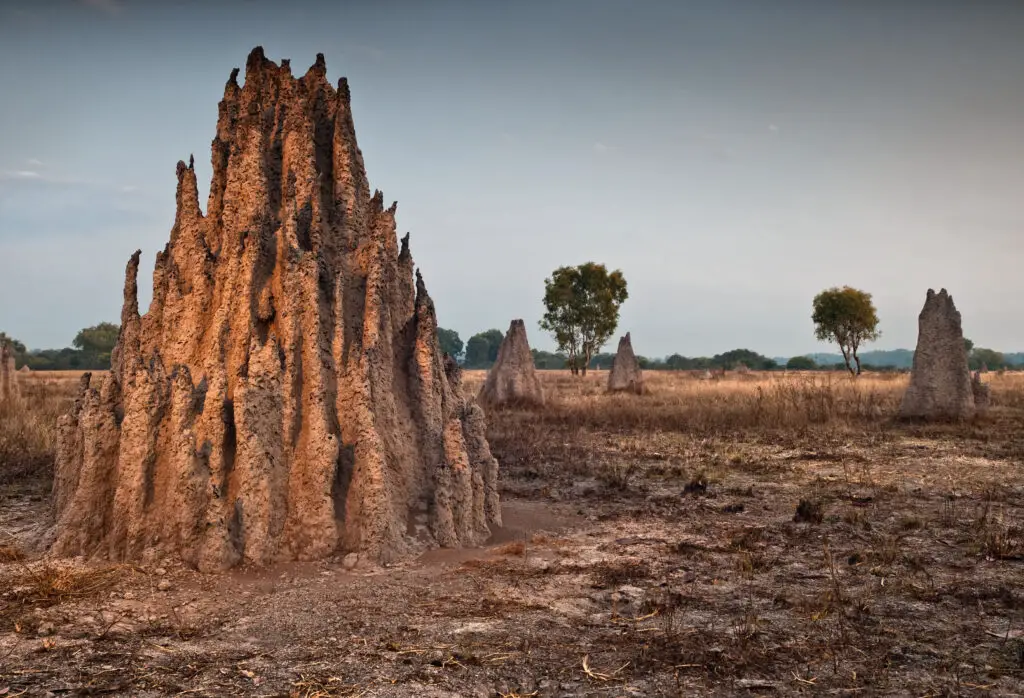
Hidden across Africa’s savannas are architectural marvels that rival human engineering feats. These towering structures, reaching heights of up to 30 feet, aren’t the work of human hands – they’re the incredible creations of tiny termites. According to Terminix, these insect-built cathedrals are engineering marvels that would make even the most skilled human architects envious. The Macrotermes michaelseni termites, barely the size of your thumb, work tirelessly in colonies of up to 2 million individuals to construct these massive mounds. These aren’t just impressive piles of dirt, but intricate networks of tunnels and chambers that put most human HVAC systems to shame. The termites’ architectural prowess extends beyond mere size; their structures are marvels of climate control and sustainability, showcasing nature’s ingenuity at its finest.
Inside these colossal constructions, termites maintain a constant temperature of around 87°F (31°C) and humidity levels of 90%, creating perfect conditions for their fungus gardens which serve as their primary food source. The mounds are not just impressive in size; they’re also remarkably durable, with some surviving for over a century. Termites use a mixture of soil, saliva, and dung to create a material stronger than concrete, capable of withstanding the harsh African climate. These structures stand as a testament to the incredible architectural prowess of nature’s tiniest builders, showcasing the power of collective effort and evolutionary design. The intricate ventilation systems within these mounds have even inspired human architects to design more energy-efficient buildings, proving that sometimes the best innovations come from the smallest creatures in the natural world.
2. The Underwater Palaces: Coral Reefs
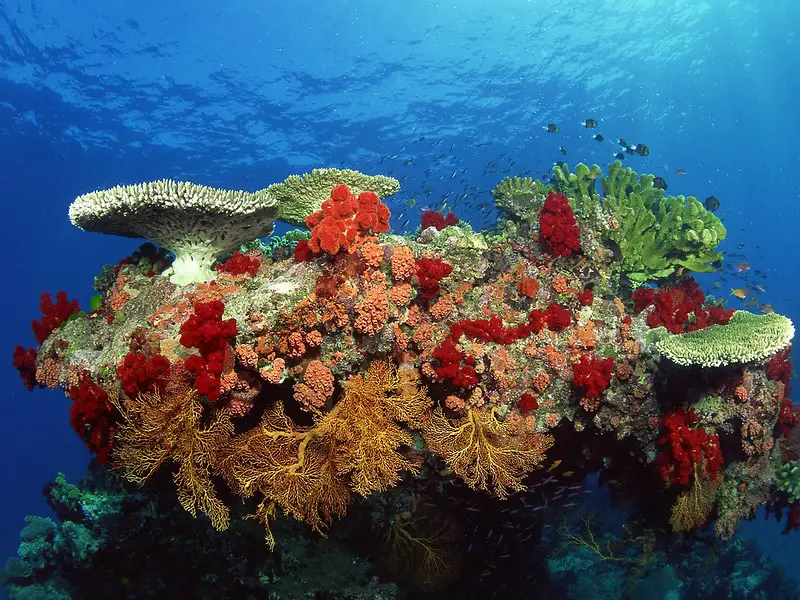
Beneath the waves lie hidden cities that rival the most impressive human metropolises. Coral reefs aren’t just visually stunning – they’re bustling underwater worlds teeming with life. Blue Reef Aquarium reveals that these living structures can span hundreds of miles, with the Great Barrier Reef visible from space at a staggering 1,429 miles long. These underwater skyscrapers are built by tiny coral polyps, each no bigger than a grain of rice. These miniature architects work non-stop, creating homes for over 1,500 species of fish, 400 species of hard coral, and even a third of the world’s soft corals. The sheer scale and diversity of these underwater ecosystems are a testament to the power of collective effort in the natural world, with each tiny polyp contributing to a structure that dwarfs even our most impressive human-made monuments.
The Great Barrier Reef alone is a marvel of biodiversity, housing 134 species of sharks and rays, and more than 30 species of whales and dolphins. Despite covering less than 1% of the ocean floor, coral reefs support an estimated 25% of all marine life. The calcium carbonate structures built by corals grow at an average rate of 0.3 to 2 centimeters per year for massive corals, and up to 10 centimeters per year for branching corals. Some of the coral structures in the Great Barrier Reef are over 20 million years old, making them one of the oldest and largest living structures on Earth. These underwater palaces are not just homes, but entire ecosystems that showcase the intricate balance of nature. The resilience and adaptability of coral reefs in the face of changing ocean conditions offer valuable lessons for human societies grappling with environmental challenges.
3. The Bachelor Pad Extraordinaire: Vogelkop Bowerbird Nest
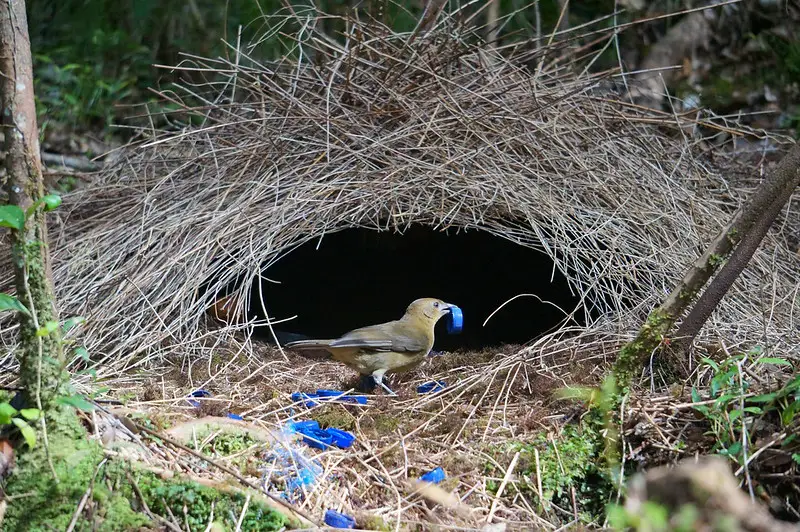
In the lush forests of New Guinea, a feathered architect is redefining the concept of home decor. The Vogelkop bowerbird takes interior design to extraordinary heights, constructing elaborate bowers that serve as stages for their mating rituals. As Earth Life reports, these avian artists build structures made of sticks and decorated with a dazzling array of colorful objects, all in an effort to impress potential mates. These bowers can reach up to 5 feet in height and are adorned with an eclectic mix of ornaments, from vibrant berries and flowers to iridescent beetle wings and even the occasional piece of discarded plastic. The bowerbird’s dedication to aesthetics and presentation challenges our understanding of art and beauty in the animal kingdom, suggesting that appreciation for color and form may be more widespread in nature than we previously thought.
The male Vogelkop bowerbird, measuring only 9.8 inches in length and weighing about 6.3 ounces, dedicates an astonishing 70% of its waking hours to building and maintaining its bower. These avian creations can contain up to 5,000 individual decorations, meticulously arranged by color, size, and type. The birds have been observed spending hours arranging and rearranging their collections, sometimes traveling miles to find the perfect decorative item. This extraordinary effort pays off in the high-stakes world of bowerbird courtship, where females visit multiple bowers before choosing a mate. The quality and aesthetic appeal of the bower play a crucial role in their decision, making these structures true works of art in the animal kingdom. The bowerbird’s meticulous attention to detail and artistic flair raise intriguing questions about the evolution of aesthetics and the role of beauty in nature’s grand design.
4. The Communal Condo Builders: Sociable Weaver Nests
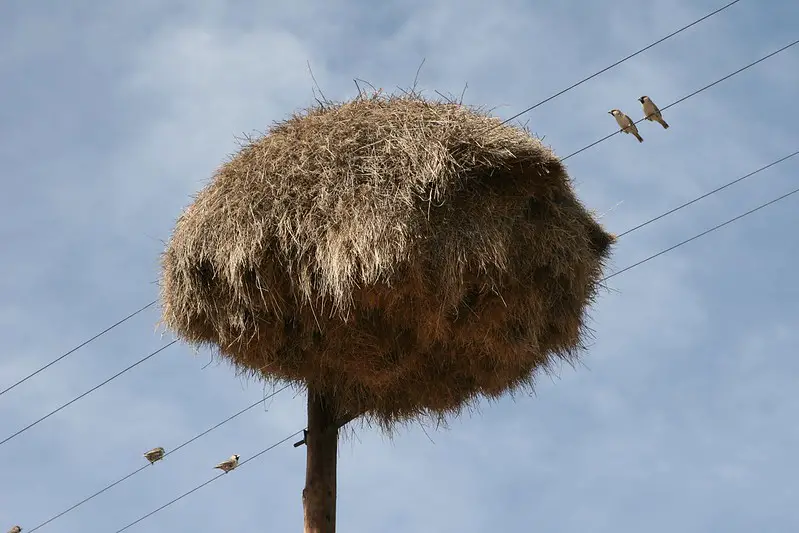
Imagine an apartment complex that can house over 400 residents, complete with temperature control and security systems. Welcome to the world of the sociable weaver bird. These feathered architects construct massive communal nests that can weigh up to 2,000 pounds (907 kg) and last for over 100 years. According to Scout Life magazine, the largest recorded nest was 20 feet (6 meters) wide and 10 feet (3 meters) high, containing 117 individual breeding chambers. These aerial metropolises are a testament to the power of collective effort, with generations of birds contributing to the construction and maintenance of a single structure. The sheer scale of these nests, often causing trees or telephone poles to buckle under their weight, showcases the impressive engineering capabilities of these small birds.
These structures are remarkably efficient at regulating temperature, maintaining an internal temperature of around 73-82°F (23-28°C) even when external temperatures range from near freezing to over 100°F (38°C). Each chamber houses a breeding pair and their offspring, with the entire colony working together to maintain and expand the structure. The sociable weaver’s architectural prowess extends beyond mere shelter; these nests serve as community hubs, fostering social interactions and providing protection from predators. The intricate design of these nests, with their multiple chambers and efficient insulation, offers valuable insights into sustainable architecture and community living that human designers could learn from.
5. The Underwater Crop Circle Creator: Pufferfish Sand Mandala
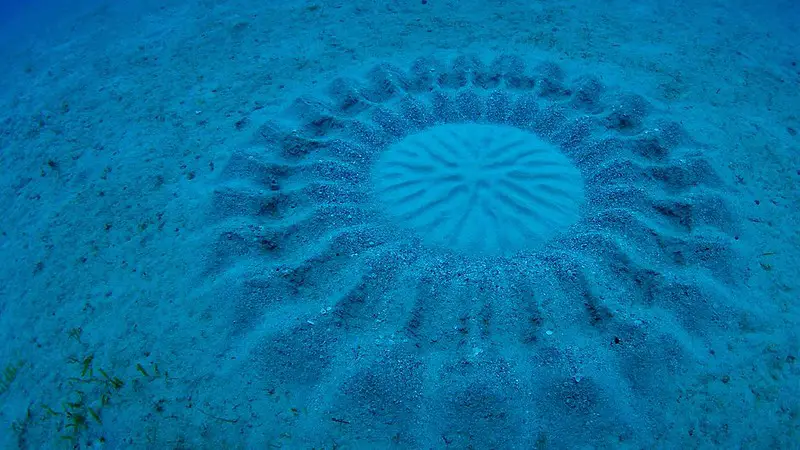
On the seafloor off the coast of Japan, mysterious circular patterns appear – not the work of aliens, but of the tiny male pufferfish (Torquigener albomaculosus). These determined fish, barely 5 inches (12.7 cm) long, spend up to 9 days creating intricate sand mandalas up to 7 feet (2.1 meters) in diameter, all to attract a mate. As Popular Mechanics describes, the pufferfish uses its fins to create valleys in the sand, each about 0.4 inches (1 cm) wide. This painstaking effort results in a structure that is not only visually stunning but also serves a crucial role in the pufferfish’s reproductive cycle. The precision and dedication displayed by these small fish challenge our perceptions of fish intelligence and artistic capability.
The entire structure can contain up to 25 radiating lines forming a spoke-like pattern. At the center of the circle, the pufferfish creates a smooth area where the female will eventually lay her eggs. The male decorates the ridges of the structure with small shells and coral fragments, carefully selecting for size and color. This meticulous attention to detail serves multiple purposes: the patterns help funnel water currents to oxygenate eggs, while the decorations may serve as nutrients for hatching fry. The pufferfish’s sand mandalas are a prime example of how nature often combines functionality with aesthetic beauty, creating structures that are both practical and visually appealing.
6. The Silk Spinners Supreme: Darwin’s Bark Spider Web
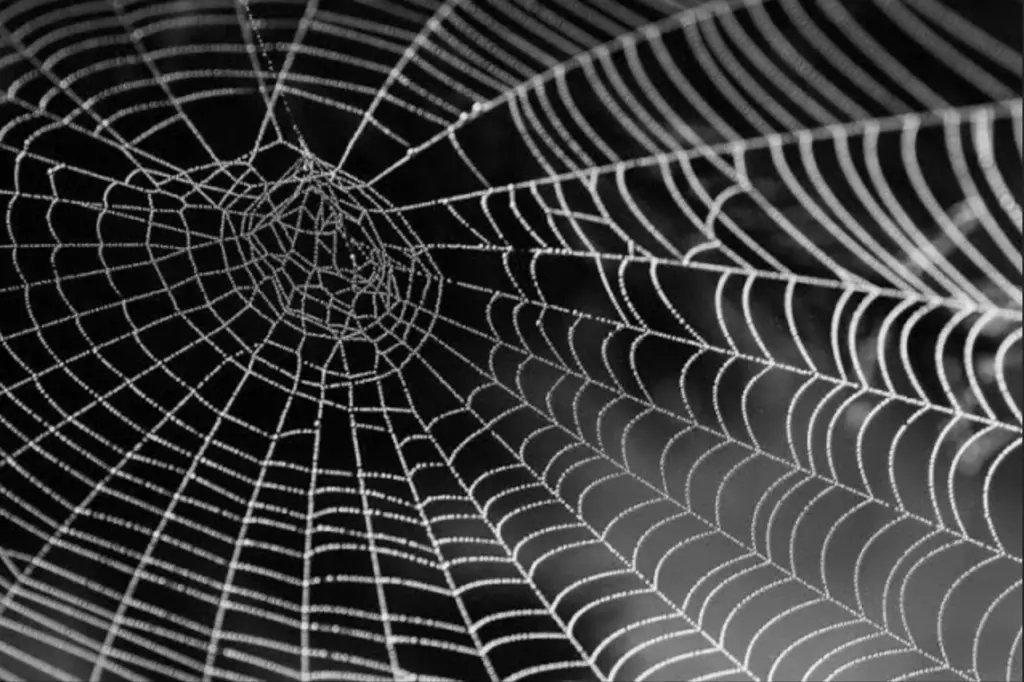
Spiders are nature’s master weavers, creating intricate webs that are not only beautiful but also incredibly strong. The Darwin’s bark spider (Caerostris darwini) produces silk that is ten times stronger than Kevlar, capable of spanning rivers up to 82 feet (25 meters) wide. These arachnid architects create orb webs that can cover an area of 30 square feet (2.8 square meters), large enough to catch small birds! The sheer scale of these webs, combined with their incredible strength, makes them one of the most impressive structures in the animal kingdom. These spiders have evolved to exploit a unique ecological niche, building their webs over rivers and lakes to catch insects that fly over water.
The tensile strength of this spider’s silk is measured at up to 520 MJ/m³, making it the toughest biological material ever studied. A single strand long enough to encircle the Earth would weigh less than 1.8 ounces (51 grams). Despite their impressive constructions, these spiders are relatively small, with females measuring only about 0.8 inches (20 mm) in body length. The Darwin’s bark spider’s web-building prowess has attracted attention from materials scientists and engineers, who hope to replicate the strength and flexibility of spider silk for various applications, from bulletproof vests to medical sutures. This remarkable spider reminds us that some of nature’s most impressive innovations come in small packages.
7. The Geometric Masters: Honeybee Hives
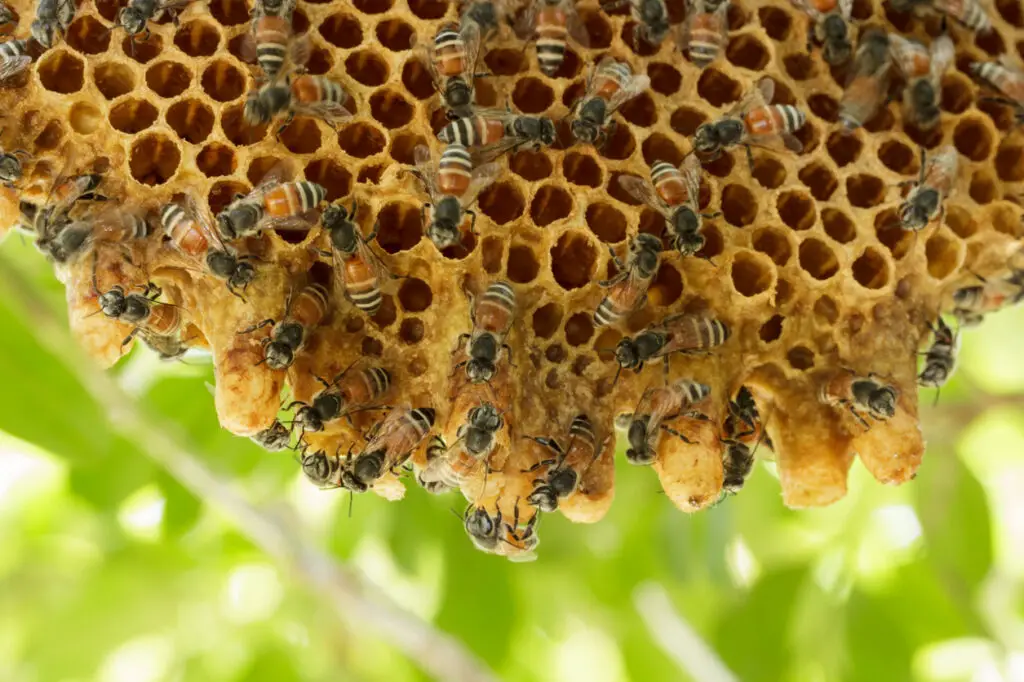
Bees are incredibly industrious insects with unparalleled building ability. Their hives are considered the most efficient structures in nature, as proven by Thomas Hales’ mathematical proof called The Honeycomb Conjecture. According to Popular Mechanics, bees use hexagonal shapes to separate the surface of their hives into equal parts, reaching 100% efficiency in design. This geometric precision allows bees to maximize storage space while minimizing the amount of wax needed for construction, a prime example of nature’s efficiency.
These structures are used for storing honey and rearing young, showcasing an efficient design that maximizes space and resources. The honeycomb cells are built with remarkable precision, with each hexagonal cell angled at exactly 13 degrees from the horizontal to prevent honey from dripping out. The wax used to construct these cells is produced by the bees themselves, secreted from special glands in their bodies. Beyond their architectural marvel, bee hives are also marvels of climate control. Bees can maintain a constant temperature inside the hive, crucial for the development of their young, by fanning their wings to circulate air. The complex social structure of bee colonies, combined with their architectural prowess, makes these insects some of nature’s most impressive builders.
8. The Underground City Planners: Prairie Dog Towns
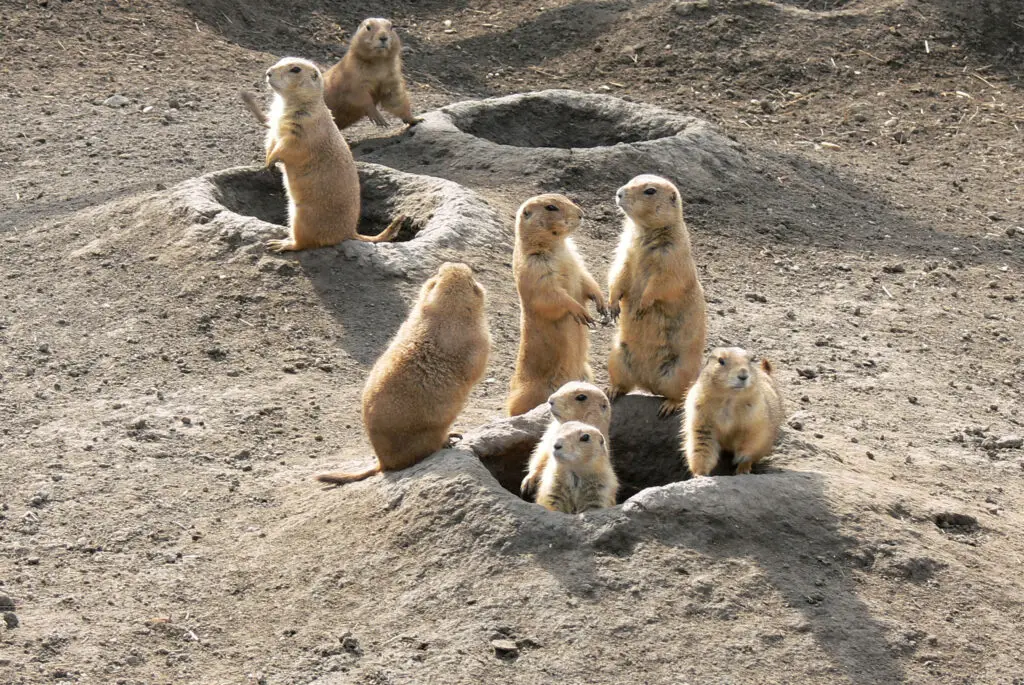
Prairie dogs are industrious diggers, creating extensive burrow systems with designated areas for sleeping, storing food, and escaping predators. These underground colonies promote safety and social interaction within their communities. As Popular Mechanics reports, prairie dog towns can cover vast areas, with one town discovered in Texas in 1900 covering 25,000 square miles and housing an estimated 400 million prairie dogs. This massive scale of construction rivals human cities in complexity and organization, showcasing the impressive engineering capabilities of these small rodents.
These complex systems are built to withstand extreme temperatures, floods, and fires, with chambers located at different depths serving various purposes. The nursery, for example, is located deep in the soil where the temperature is more stable and young prairie dogs are better protected from predators. Prairie dog burrows also feature multiple entrances and exits, intricate tunnels, and even listening posts near the surface where sentries can watch for danger. The sophistication of these underground cities extends to their ventilation systems, which maintain air circulation throughout the burrow network. Prairie dogs’ architectural skills not only benefit their own species but also create habitats for other animals, making them crucial ecosystem engineers in grassland environments.
9. The Avian Weavers: Montezuma Oropendola Nests
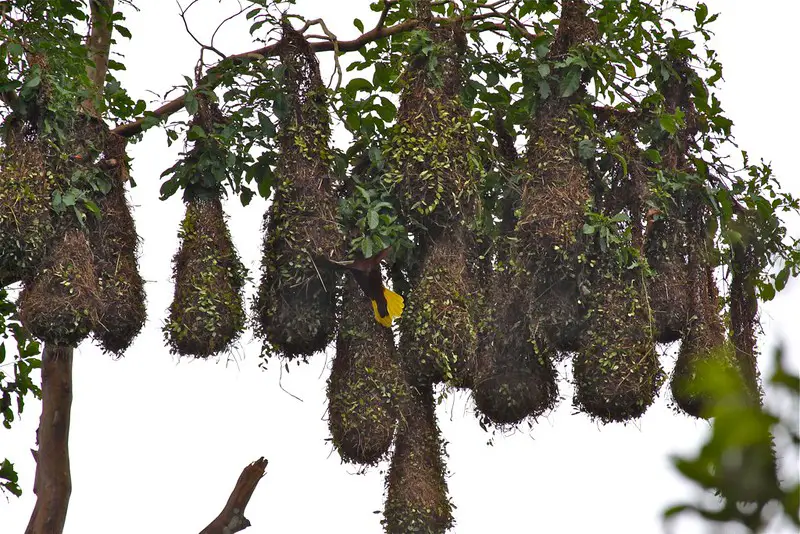
The Montezuma oropendola builds elaborate hanging nests in trees in Central America. They use vines to weave pendulous baskets, grouping the nests together into colonies. As described by Popular Mechanics, these tropical subdivisions are often located in large, isolated trees, with the nests hanging from the flimsy far end of the branches to discourage raiding monkeys from trying to climb out to devour the precious eggs. This strategic placement showcases the birds’ ability to consider and counteract potential threats in their architectural designs.
These nests can be up to 6 feet (1.8 meters) long and are built by males to attract females. The birds often build their colonies near wasp or bee nests for added protection from predators. Each colony typically contains 30-100 nests, with the dominant male mating with most of the females. The construction process is a marvel of avian engineering, with the birds carefully selecting and weaving together flexible vines and fibers to create a sturdy, weatherproof structure. The entrance to each nest is near the top, providing additional protection from the elements and predators. The Montezuma oropendola’s architectural skills not only provide a safe haven for their young but also serve as an impressive display of craftsmanship in the animal kingdom.
10. The Woodworking Specialists: Woodpecker Cavities
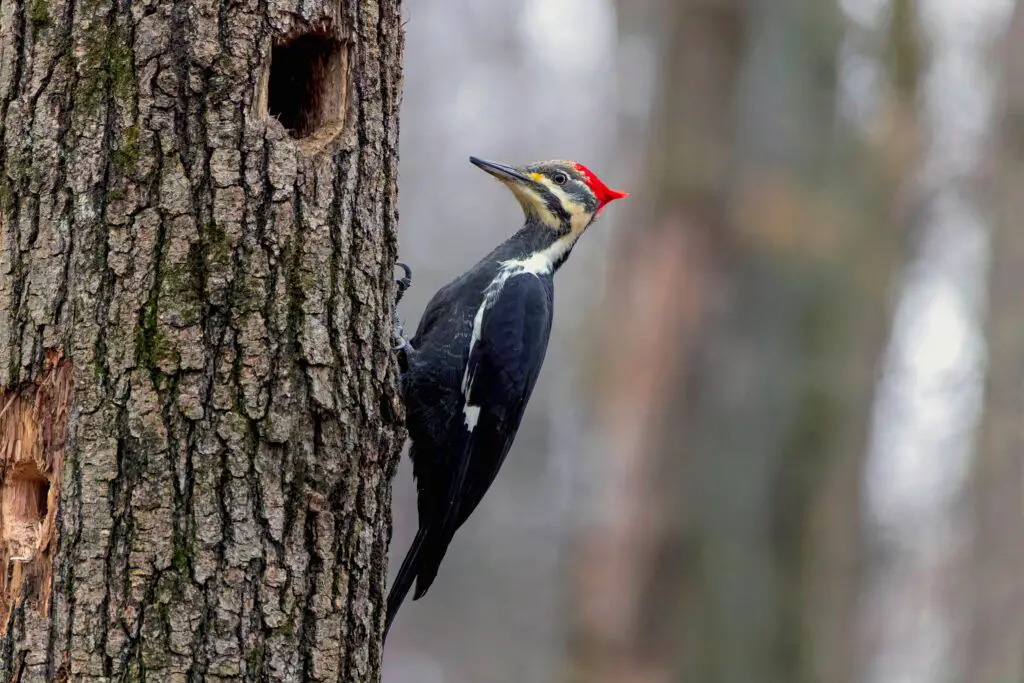
Woodpeckers specialize in carving out nesting holes in trees, showcasing their impressive carpentry skills in the animal kingdom. These wooden cavities offer safe spaces for raising their young and are later utilized by other species as ready-made shelters. According to Scout Life magazine, woodpecker cavities can vary in size depending on the species, with some excavations taking up to a month to complete. The precision and effort involved in creating these homes demonstrate the woodpeckers’ remarkable ability to shape their environment to suit their needs.
These cavities not only serve as nests but also provide shelter from predators and harsh weather. Some woodpecker species may create multiple cavities each year, contributing significantly to forest ecosystems by providing homes for various other animals. The process of excavation is a feat of endurance and skill, with woodpeckers using their specialized beaks and neck muscles to chip away at wood for hours on end. Interestingly, woodpeckers often choose trees that are partially decayed or infected with fungi, as these are easier to excavate and may provide a food source in the form of insects. The architectural prowess of woodpeckers extends beyond mere hole-drilling; they carefully design the cavity’s interior, ensuring proper depth, width, and drainage to create an ideal living space.
11. The Underwater Den Designers: Octopus Shelters
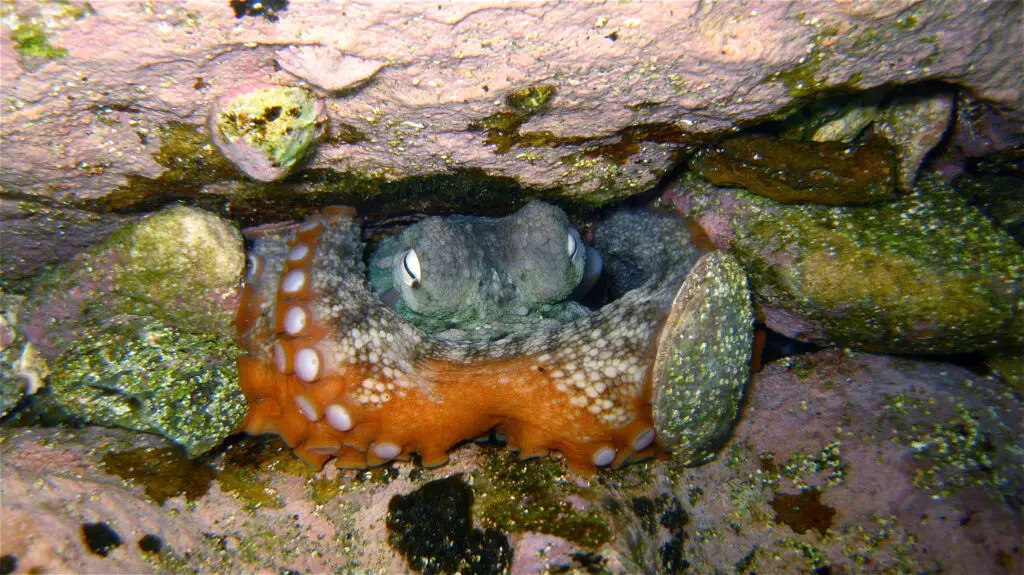
Octopuses are underwater architects, assembling shells, stones, and debris to create secure dens that serve as both homes and fortresses. These shelters provide protection from predators and serve as resting spots and safe places for laying eggs. While specific studies on octopus den decoration are limited, these intelligent creatures are known to arrange objects around their dens, possibly for camouflage or protection. The octopus’s ability to manipulate its environment showcases its problem-solving skills and adaptability, traits that have fascinated marine biologists for decades.
The size and complexity of octopus dens can vary greatly depending on the species and individual. Some octopuses have been observed using coconut shells as portable shelters, demonstrating their problem-solving abilities and adaptability. This behavior, often referred to as “tool use,” highlights the octopus’s remarkable intelligence. Octopuses have also been known to create barriers at the entrance of their dens using rocks and shells, effectively creating a door that can be closed for added security. The architectural skills of octopuses extend beyond mere shelter-building; they often modify their dens to suit changing needs, such as expanding the living space as they grow or creating separate chambers for different purposes. This dynamic approach to home design showcases the octopus’s ability to plan and adapt, traits we often associate with much more complex animals.


